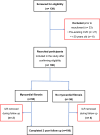Ventricular Arrhythmia and Cardiac Fibrosis in Endurance Experienced Athletes (VENTOUX)
- PMID: 40675176
- PMCID: PMC12356567
- DOI: 10.1161/CIRCIMAGING.125.018470
Ventricular Arrhythmia and Cardiac Fibrosis in Endurance Experienced Athletes (VENTOUX)
Abstract
Background: Sudden cardiac death due to primary arrhythmia is a leading cause of mortality in athletes, predominantly affecting older male athletes. Myocardial fibrosis is strongly associated with arrhythmogenesis in nonischemic cardiomyopathy, but its clinical significance in asymptomatic endurance athletes is unknown. We aimed to investigate whether myocardial fibrosis on cardiovascular magnetic resonance in asymptomatic veteran male athletes was associated with incident ventricular arrhythmia on long-term implantable loop recorder.
Methods: Prospective observational cohort study involving 106 asymptomatic male competitive cyclists/triathletes (aged ≥50 years) who undertook ≥10 h/wk of exercise for ≥15 years. Exclusion criteria were any preexisting cardiovascular disease. Participants underwent clinical assessment, stress-perfusion late gadolinium enhancement-cardiovascular magnetic resonance, exercise testing, and implantable loop recorder implantation to detect ventricular arrhythmia. Athletes were followed up for the primary end point of incident ventricular arrhythmia.
Results: A total of 50/106 (47.2%) athletes had focal myocardial fibrosis (all nonischemic distribution) on cardiovascular magnetic resonance predominantly affecting the basal inferolateral left ventricular segment. During follow-up (median 720 days), 23/106 (21.7%) athletes experienced ≥1 ventricular arrhythmic episode; 3/106 (2.8%) sustained ventricular tachycardia, and 20/106 (18.9%) nonsustained ventricular tachycardia. Myocardial fibrosis (hazard ratio, 4.7 [95% CI, 1.8-12.8]; P=0.002) and greater left ventricular end-diastolic volume indexed (hazard ratio, 1.4 [95% CI, 1.1-1.9]; P=0.02) were associated with an increased risk of incident ventricular arrhythmia, but right ventricular insertion point late gadolinium enhancement was not (hazard ratio, 1.7 [95% CI 0.6-5.1]; P=0.32). Myocardial fibrosis remained predictive after adjusting for left ventricular end-diastolic volume indexed (hazard ratio, 4.7 [95% CI, 1.7-12.7]; P=0.002).
Conclusions: In male veteran endurance athletes, myocardial fibrosis was independently associated with the onset of ventricular arrhythmia, even after adjusting for left ventricular dilatation. Right ventricular insertion point late gadolinium enhancement was not associated with ventricular arrhythmia. Further studies are needed to establish whether myocardial fibrosis itself is arrhythmogenic or a marker of an underlying cardiomyopathic process.
Keywords: athletes; dilatation; fibrosis; perfusion.
Conflict of interest statement
None.
Figures




Comment in
-
High-Intensity Exercise, Fibrosis, and Ventricular Arrhythmias: How Much Is Too Much?Circ Cardiovasc Imaging. 2025 Aug;18(8):e018716. doi: 10.1161/CIRCIMAGING.125.018716. Epub 2025 Jul 17. Circ Cardiovasc Imaging. 2025. PMID: 40675175 No abstract available.
Similar articles
-
Long-Term Risk Assessment in Athletes With Complex Ventricular Arrhythmias.Circ Arrhythm Electrophysiol. 2025 Jun;18(6):e013480. doi: 10.1161/CIRCEP.124.013480. Epub 2025 May 28. Circ Arrhythm Electrophysiol. 2025. PMID: 40433698
-
Extent and Features of Late Gadolinium Enhancement Stratify Arrhythmic Risk in Patients With Biopsy-Proven Sarcoidosis.JACC Cardiovasc Imaging. 2025 Jul;18(7):768-780. doi: 10.1016/j.jcmg.2025.02.012. JACC Cardiovasc Imaging. 2025. PMID: 40634021
-
[The predictive value of cardiac MRI for the first episode of malignant ventricular arrhythmias in arrhythmogenic right ventricular cardiomyopathy].Zhonghua Xin Xue Guan Bing Za Zhi. 2025 Jul 24;53(7):784-791. doi: 10.3760/cma.j.cn112148-20250117-00055. Zhonghua Xin Xue Guan Bing Za Zhi. 2025. PMID: 40707383 Chinese.
-
Presence of Late Gadolinium Enhancement by Cardiac Magnetic Resonance Among Patients With Suspected Cardiac Sarcoidosis Is Associated With Adverse Cardiovascular Prognosis: A Systematic Review and Meta-Analysis.Circ Cardiovasc Imaging. 2016 Sep;9(9):e005001. doi: 10.1161/CIRCIMAGING.116.005001. Circ Cardiovasc Imaging. 2016. PMID: 27621357 Free PMC article.
-
Late gadolinium enhancement on cardiac magnetic resonance predicts adverse cardiovascular outcomes in nonischemic cardiomyopathy: a systematic review and meta-analysis.Circ Cardiovasc Imaging. 2014 Mar;7(2):250-258. doi: 10.1161/CIRCIMAGING.113.001144. Epub 2013 Dec 20. Circ Cardiovasc Imaging. 2014. PMID: 24363358 Free PMC article.
References
-
- Zeppenfeld K, Tfelt-Hansen J, de Riva M, Winkel BG, Behr ER, Blom NA, Charron P, Corrado D, Dagres N, de Chillou C, et al. ; ESC Scientific Document Group. 2022 ESC guidelines for the management of patients with ventricular arrhythmias and the prevention of sudden cardiac death: developed by the task force for the management of patients with ventricular arrhythmias and the prevention of sudden cardiac death of the European Society of Cardiology (ESC) Endorsed by the Association for European Paediatric and Congenital Cardiology (AEPC). Eur Heart J. 2022;43:3997–4126. doi: 10.1093/eurheartj/ehac262
-
- Chugh SS, Weiss JB. Sudden cardiac death in the older athlete. J Am Coll Cardiol. 2015;65:493–502. doi: 10.1016/j.jacc.2014.10.064 - PubMed
-
- Finocchiaro G, Papadakis M, Robertus JL, Dhutia H, Steriotis AK, Tome M, Mellor G, Merghani A, Malhotra A, Behr E, et al. Etiology of sudden death in sports: insights from a United Kingdom regional registry. J Am Coll Cardiol. 2016;67:2108–2115. doi: 10.1016/j.jacc.2016.02.062 - PubMed
-
- Tahir E, Starekova J, Muellerleile K, von Stritzky A, Munch J, Avanesov M, Weinrich JM, Stehning C, Bohnen S, Radunski UK, et al. Myocardial fibrosis in competitive triathletes detected by contrast-enhanced CMR correlates with exercise-induced hypertension and competition history. JACC Cardiovasc Imaging. 2018;11:1260–1270. doi: 10.1016/j.jcmg.2017.09.016 - PubMed
-
- Javed W, Malhotra A, Swoboda P. Cardiac magnetic resonance assessment of athletic myocardial fibrosis; benign bystander or malignant marker? Int J Cardiol. 2024;394:131382. doi: 10.1016/j.ijcard.2023.131382 - PubMed
Publication types
MeSH terms
LinkOut - more resources
Full Text Sources
Medical

